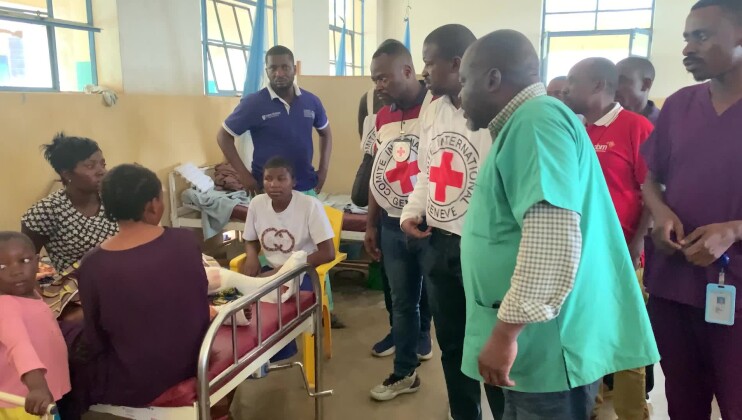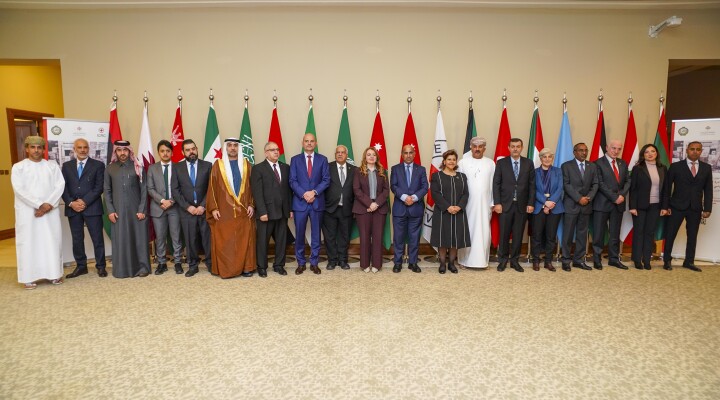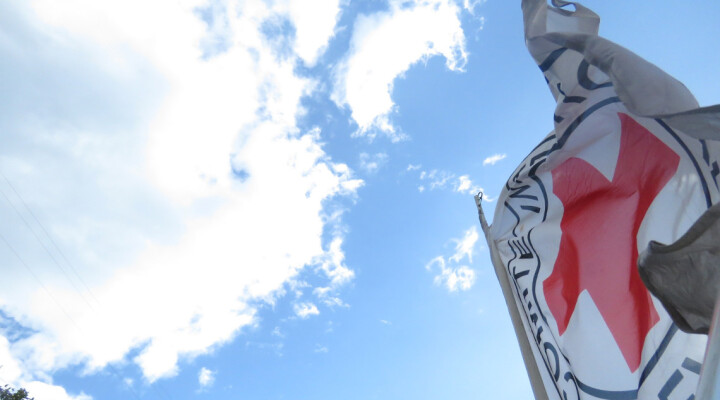India Makeathon: Low cost prototypes for those with disabilities
Of the world’s seven billion people, one billion are living with disabilities. In rural areas, and in developing countries, the challenges to living a normal life can seem insurmountable.
The simplest things: getting to the shops, going to school, finding a job and going to work, can be out of reach.
Like all parents, Ramesh wants the best for his son Vishwananth. “My son has a severe disability,” explains Ramesh. “Somebody is required to help him with all activities, even to fan the mosquitoes away from him as he can’t even do that much.”
“He is interested in studying,” Ramesh continues. “Someone is required to take him to school… feed him during the break and bring him back after school finishes. We have shown him to all possible doctors but none can help.”
The ICRC has been considering ways to help people, especially in rural areas, with disabilities. As the ICRC’s Head of Innovation Tarun Sarwal explains, the need is huge.
“The ICRC already does a lot of work in conflict areas and in rural areas for people with disability but if you look at their needs they are far greater,” says Tarun. “We don’t have the products, we don’t have the different kind of assistive devices that people need in those areas to live normal lives. There are problems with daily living, there are problems with mobility; there are problems with us being able to service them at distance.”
And so the ICRC came up with an innovative plan to harness skills and talents worldwide in a Makeathon, in which budding inventors and entrepreneurs were given a simple, but important, task, to come up with practical, affordable devices to support people with disabilities to live a normal productive life.
Over several months, innovators brainstormed. Their ideas ranged from wheelchairs adapted to work on bumpy rural tracks, to prosthetic feet designed for rough terrain, to specially designed cutlery, pens, and pencils.
Finally, the inventors gathered at a Makeathon demo day organized by the ICRC. All the new inventions were on display, to be examined and tested. At the end of the day, three devices would be chosen as winners, and their inventors given seed money to put their prototypes into production.
With so many promising devices on offer, finding a winner was difficult, but Mobility India’s children’s wheelchair, designed to help children with cerebral palsy or spinal cord injuries sit, stand, and simply get about more easily certainly caught the judge’s eye. ”We are addressing the four to five million children with developmental challenges in the country,” explained Mobility Team’s Soikat Ghosh. “I am not talking about the global – just in India there are 4 to 5 million children who are waiting for this invention – for this need. So it becomes very important for us.”
American Gary Wall’s Innovative design for prosthetic limbs was rewarded with second place. “It feels great, you know we travelled a long distance to get here,: he said. “Meeting everybody from all over the globe here in India: it is a great experience.”
“It feels really very good,” added third place winner, Team RightFit Prosthetics, whose low-cost, energy-storing prosthetic foot also impressed the judges. “I think we really understood the need, and we made a very good product which meets that need, and we are planning to take it forward. So, given that it’s an end to end solution, which we are planning to produce, I think that’s the reason we won.”
So where do the products go from here? Well, hopefully into production and then distribution to millions of disabled people who can benefit from them.
“I think it is going to be very useful for many different reasons,” said Boris Michel, ICRC Director of Operations Asia-Pacific. “Many people are affected by conflict, by violence, and that has physical consequences for them. But also we have millions of people who are affected by disease, by poverty, and they also have similar needs in terms of physical rehabilitation, in terms of being cured, and in terms of receiving easy and cheap solutions in order to help them in their daily life.”
Millions of people should benefit from the new devices. Some of the world’s finest innovators got involved, they came up with some complex and innovative designs. But all for one very straightforward goal: to help people with disabilities live normal lives, and do the normal things are often taken for granted: go to school, go to work, or simply just play.
Shotlist
Location: IKP Eden, Bengaluru
Length: 6:56
Format: H264-Mov (1920x1080p50)
Production: Ashish Bhatia
Camera: Canon 5D
Sound: English/
ICRC ref: AV424N
Date: 23/01/2016
Copyright: ICRC access all
0:00 - 0:05 Woman in wheelchair being pushed through fields
0:05 – 0:10 Close up wheel
0:10 – 0:17 Young man at home with calipers
0:17 – 0:30 Young man gets up goes to crutches
0:30 – 0:40 Young woman on crutches going for water
0:40 – 0:44 Close up trying to get water
0:44 – 0:49 Young boy Vishwananth at home in chair
0 :50 – 0 :54 close up hand writing
0 :54 – 1:01 tilt up again Vishwananth in chair
1 :02 – 1 :32 Soundbite Vishwananth’s father Ramesh.
“My son has a severe disability. Somebody is required to help him with all activities, even to fan the mosquitoes away from him as he can’t even do that much. He is interested in studying. Someone is required to take him to school… feed him during the break and bring him back after school finishes. We have shown him to all possible doctors but none can help.”
1 :32 – 1 :39 tilt up hands to Vishwananth and brother
1 :39 – 2 :04 Soundbite ICRC Head of Innovation Tarun Sarwal :“
The ICRC already does a lot of work in conflict areas and in rural areas for people with disability but if you look at their needs they are far greater,” says Tarun. “We don’t have the products, we don’t have the different kind of assistive devices that people need in those areas to live normal lives. There are problems with daily living, there are problems with mobility; there are problems with us being able to service them at distance.”
2 :04 – 2 :08 New wheelchair design
2 :08 – 2 :12 New cutlery design
2 :12 – 2 :16 new device for computing
2 :16 – 2 :20 prosthetic leg
2 :20 – 2 :23 Electronic prosthetic leg
2 :23 – 2 :30 Close up same
2 :31 – 2 :34 Makethon Demo Day sigh
2 :34 – 2 :38 New design mobility vehicles rolling in
2 :38 – 2 :44 Wider shot same
2 :44 – 2 :49 Inventors on stage explaining their products
2 :49 – 2 :51 Mobility vehicle
2 :51 – 2 :57 audience watching
2 :57 – 3 :04 audience from over shoulder of inventor
3 :04 – 3:07 people looking at Mobility India chair for children
3 :07 – 3 :12 same
3 :12 – 3:22 Mobility India inventors describing product
3 :22 – 3 :25 Mobility India chairs being wheeled away
3 :26 – 3 :32 chairs being assembled
3 :32 – 3:37 Gary Wall addressing audience
3 :38 - 3 :43 Close up prosthetic leg
3 :43 – 3 :45 Same different angle
3 :45 – 3:48 inventor with prosthetic leg
3 :48 – 3:51 close up leg being demonstrated
3 :51 – 3 :56 inventor from back with leg
3 :57 – 4 :00 wheelchair being demonstrated
4 :00 – 4:04 Boris and inventor looking it ipad
4 :04 – 4 :08 inventors and viewers chatter
4 :08 – 4 :19 announcement of winner
4 :20 – 4 :25 Mobility India go up to podium
4 :25 – 4 :29 Mobility India receive cheque
4 :29 – 4 :43 Soundbite Soikat Ghosh of Mobility India :
"We are addressing the four to five million children with developmental challenges in the country. I am not talking about the global – just in India there are 4 to 5 million children who are waiting for this invention – for this need. So it becomes very important for us.”
4 :44 – 4 :46 Winners on podium
4 :46 – 4 :55 Soundbite Gary Wall ‘It feels great, you know we travelled a long distance to get here,: he said.
“Meeting everybody from all over the globe here in India: it is a great experience.”
4 :56 – 5 :14 Third runner up team ( ?) cheering and soundbite
“It feels really very good. I think we really understood the need, and we made a very good product which meets that need, and we are planning to take it forward..So, given that it’s an end to end solution, which we are planning to produce, I think that’s the reason we won.”
5 :15 – 5 :20 Women on mobility vehicle, interior
5 :20 – 5 :26 working on vehicles, interior
5 :26 – 5 :53 Soundbite Boris Michel, ICRC Director of Operations Asia-Pacific
“I think it is going to be very useful for many different reasons. Many people are affected by conflict, by violence, and that has physical consequences for them. But also we have millions of people who are affected by disease, by poverty, and they also have similar needs in terms of physical rehabilitation, in terms of being cured, and in terms of receiving easy and cheap solutions in order to help them in their daily life.’
5 :54 – 6 :22 Vishwananth in wheelchair various
6 :22 – 6 :37 Young man with calipers in mobility vehicle various
6 :38 – 6 :41 CU young boy’s face concentrating
6 :41 – 6 :46 CU picture he is drawing
6 :47 – 6 :56 young boy playing cricket



